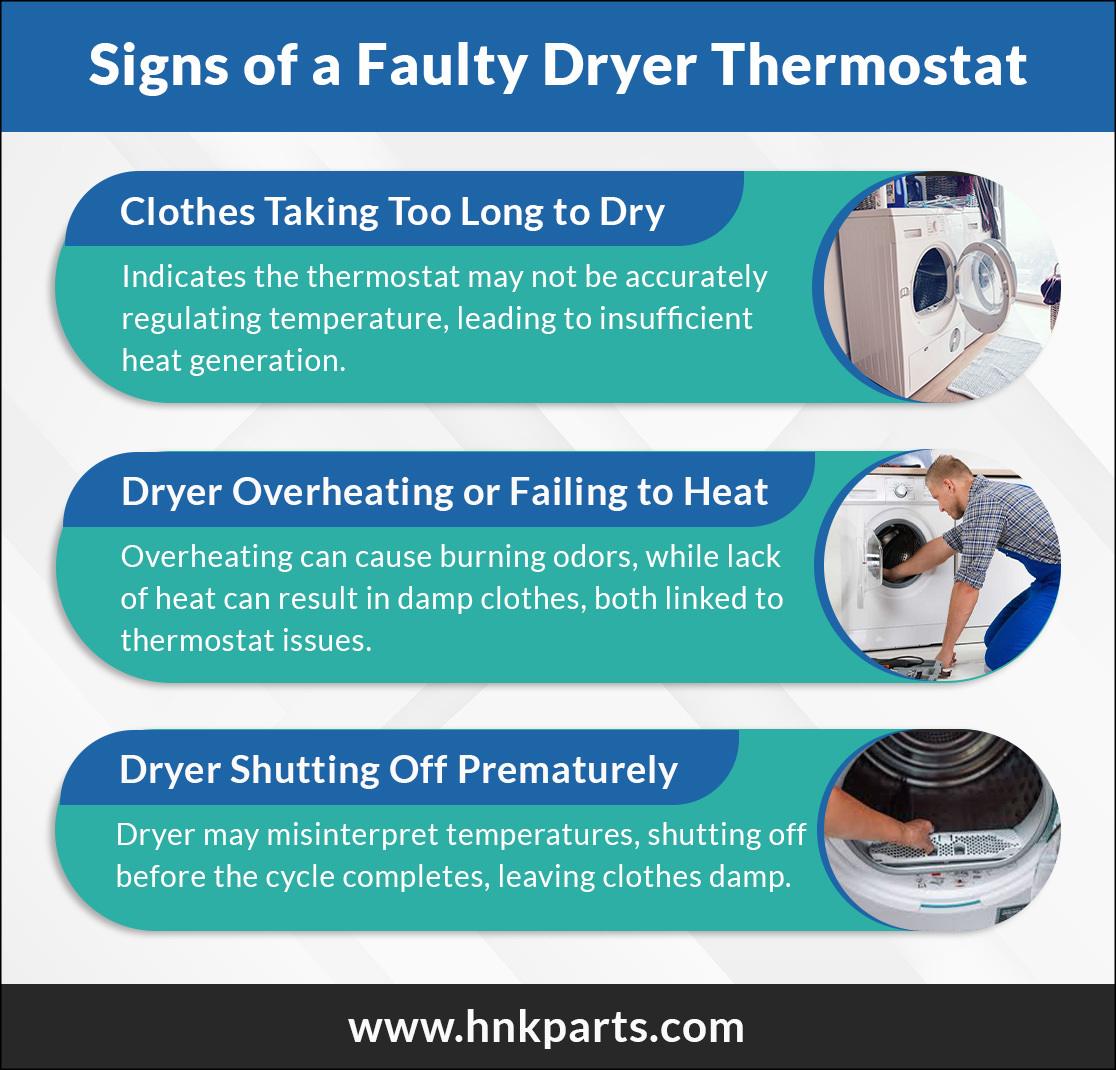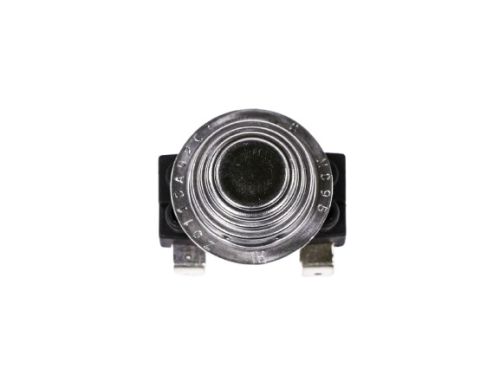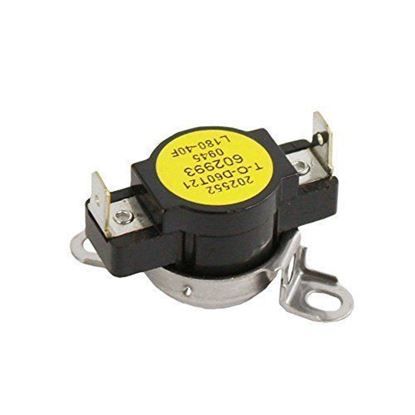
How to Replace a Faulty Dryer Thermostat
Proper care and maintenance of dryer parts will ensure safe working as well as effective working. Wear or malfunction of dryer parts will reduce performance, increase the energy used, or, in some cases, create safety hazards. For your dryer to properly function you should perform regular maintenance and promptly replace parts, such as fuses, belts, and thermostats. The thermostat is one of the main elements that ensure the efficiency of a dryer. A dryer thermostat is a very important device for controlling of temperature inside the dryer drum for proper drying clothing without overheating. This component serves to keep the temperature consistent during the drying cycle, promote energy efficiency, and protect the dryer from the hazard of overheat.
| Table of Contents What is a Dryer Thermostat? Types of Dryer Thermostats Signs of a Faulty Dryer Thermostat How to Check and Test a Dryer Thermostat Replacing a Faulty Dryer Thermostat Comparison of Dryer Thermostats Across Popular Brands Preventative Maintenance for Long-Lasting Performan |
What is a Dryer Thermostat?
A clothes dryer thermostat is an important part of a clothes dryer that controls the temperature inside the drum while the dryer is running. The primary function is to maintain the proper temperature at the dryer to ensure effective drying without too much overheating that might inflict damage or cause safety risks. The thermostat keeps tabs on and regulates the temperature to protect the dryer, clothing, and household from the dangers of too much heat.
Role in Controlling Dryer Temperature
The heater is controlled by a signal from the dryer thermostat: when the temperature in the dryer is below a certain level the heater is turned on, otherwise off. The thermostat opens the circuit and the heating element shuts off by opening the circuit when the temperature gets to a selected level. Once the temperature reaches a certain level, the thermostat closes the circuit, letting the heating element run again. This makes it a cycle that keeps the desired drying temperature.
Types of Dryer Thermostats
- Dryer cycling thermostat (145 Degrees): The cycling thermostat is intended to operate at an optimal drying temperature of 145 degrees Fahrenheit (63 degrees Celsius). It runs continuously for the dryer’s drying cycle, avoiding overheating while also providing enough heat for effective drying.
- Dryer high limit thermostat: All newer dryers come with a high-limit thermostat, which is a safety feature and prevents the dryer from overheating. The cycling thermostat is set at a higher temperature than this thermostat and will turn off the heating element if the temperature gets too high. This prevents potential fire hazards and damage in the dryer.
Signs of a Faulty Dryer Thermostat
The dryer thermostat is a critical component that helps regulate the temperature inside your dryer during operation. If it becomes faulty, it can lead to a variety of drying issues.

How to Check and Test a Dryer Thermostat
When your dryer isn't functioning properly, one potential culprit could be a faulty thermostat. This component regulates the temperature and ensures the dryer operates efficiently. Here’s how to check and test your dryer thermostat.
How to Check Dryer Thermostat
- Unplug the dryer: Never begin work on your dryer before shutting off the power source (unplugging the dryer or shutting down the circuit breaker).
- Access the thermostat: In the case of the dryer model, the thermostat can vary its location (generally inside the dryer cabinet). Next, use a screwdriver to take out the screws that hold the dryer’s access panel (or back or front of the dryer).
- Locate the thermostat: The thermostat is usually a small metal or plastic component with two or three electrical leads attached. It may be attached to or near the heating element assembly.
How to Test Dryer Thermostat
- Inspect for physical damage: Before you use a multimeter, visually inspect the thermostat to look for any obvious signs of physical damage such as burns, corrosion, or broken wires.
- Disconnect wires: Disconnect wires from the thermostat carefully. Make note of who they are connected to, or take a picture to reference when you reconnect later.
- Set up your multimeter: To measure continuity, set your multimeter to the “ohms” (Ω) setting.
- Continuity test: Insert the multimeter probes into the terminals of the thermostat. A good thermostat should read close to zero ohms (continuity). If you see “OL” (over limit) or a higher resistance reading, the thermostat is probably bad.
Get the most out of your dryer with our expert breakdown of essential dryer parts and maintenance tips
Replacing a Faulty Dryer Thermostat
In some models of the dryer, you'll need to remove the thermostat from the back or top of the dryer. Find some screws to attach the panel with a screwdriver.
- Locate the thermostat: After you get inside, find the thermostat. Usually, it is located close to the heating element or on the blower housing.
- Disconnect wires: Carefully write down the wire connections on the old thermostat. If you feel the need, a multimeter can check for continuity, marking the wire position with tape, or taking a photo for reference.
- Remove the old thermostat: Remove the old thermostat by unscrewing or unclipping it from its mounted position.
- Installing the new thermostat: Make sure that the new thermostat is OK for your dryer model. Get a feel for the connections and how it mounts.
- Position the new thermostat: Put the new thermostat in the same place as the old one. Screw or clip those back in place to secure it.
- Reconnect wires: Go back to your notes, or reference photo, and reconnect the wires to the new thermostat. Make sure connections are tight and in place securely.
Upgrade your laundry routine with cutting-edge washers and dryers of 2024
Comparison of Dryer Thermostats Across Popular Brands
Different brands of dryers may have specific thermostat types and configurations, but their core functions remain consistent. Here is a brief overview of thermostats from several popular dryer brands:
|
Brand |
Key Features of Thermostats |
Approximate Price Range |
|
Whirlpool dryer thermostat |
Safe and efficient drying is assured by reliable cycling and high limit thermostats. |
$15–$30 |
|
Samsung dryer thermostat |
Energy efficiency and drying performance is enhanced by advanced sensors and thermostats. |
$25–$50 |
|
Kenmore dryer thermostat |
Temperature control vs. user convenience is balanced in straightforward systems. |
$20–$35 |
|
LG dryer thermostat |
Technology helps dry with consistent temperature control, and to optimize drying cycles. |
$30–$60 |
|
Maytag dryer thermostat |
High-usage thermostats are built for heavy usage and optimum performance. |
$25–$40 |
|
Amana dryer thermostat |
Reliable thermostat systems manage heat levels for dependable drying. |
$15–$30 |
|
GE dryer thermostat |
Safety, energy efficiency, and efficient heat management are emphasized in innovative designs. |
$20–$45 |
Preventative Maintenance for Long-Lasting Performance
|
Maintenance Task |
Description |
|
Clean lint traps after every use |
Remove accumulated fibers from lint traps to ensure drying efficiency and reduce fire hazards. |
|
Inspect and clean dryer vents annually |
Clear lint build-up from vents and ductwork to prevent airflow restrictions, overheating, and fire risks. |
|
Test and replace thermostats periodically |
Check the thermostat for proper function and replace it if overheating or inconsistent drying occurs. |
|
Use high-quality dryer parts |
Invest in reliable replacement parts, such as belts, rollers, and heating elements, for optimal performance. |
|
Regular inspections |
Check for unusual noises, drying inconsistencies, or signs of wear to address issues early and avoid costly repairs. |
A dryer thermostat is an important part of your dryer operating efficiently. This is a vital component as it controls the temperature of the appliance to dry clothes while not overheating to cause potential safety hazards. Having a properly functioning thermostat is critical to ensuring your dryer works as well as it should and lasts as long as it should. However, with the right maintenance and timely replacement, your dryer can be kept running efficiently for years to come. HnKParts offers an extensive selection of dryer replacement parts for electric and gas dryers from leading manufacturers. Our appliance components and accessories are authentic and dependable.
FAQs
Why is it important to check the dryer thermostat?
Checking the dryer thermostat helps diagnose drying issues, restore efficiency, improve drying times, and prevent overheating or fire hazards. Regular maintenance enhances safety and prevents appliance damage.
What is the function of a dryer cycling thermostat?
It maintains an optimal drying temperature of 145°F (63°C) to avoid overheating and ensure effective drying.
What is the purpose of a high-limit thermostat in a dryer?
It acts as a safety feature to prevent overheating by shutting off the heating element if the temperature exceeds safe levels














